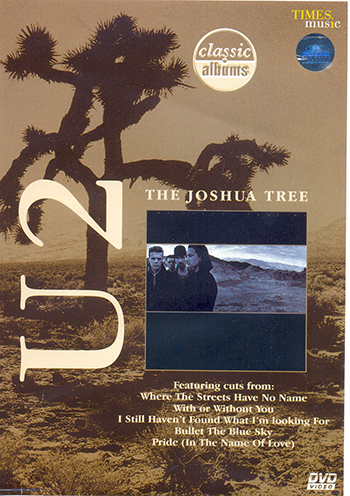 U2 – The Joshua Tree (Times Music) Rs. 499/-
U2 – The Joshua Tree (Times Music) Rs. 499/-
U2’s sixth album ‘The Joshua Tree’ released in March 1987 became the fastest selling album in British chart history, selling almost 250,000 copies in the first week of release. In the US the reception was the same with the album topping the Billboard charts and also winning a Grammy for Album of the Year.
On this DVD the story of the making of the Joshua Tree is told via interview and archive film footage, with contributions from band member’s drummer Larry Muller, who had the original idea of forming a band back in 1977. There’s also bassist Adam Clayton, singer, Paul “Bono Vox” Hewson (that meant ‘good voice’) and guitarist Dave “The Edge” Evans, who all met years ago at Dollfin’s Mount Temple School.
U2’s longtime manager Paul McGuinness reveals how the album catapulted the band into the category of rock superstars. There’s also singer Elvis Costello in the beginning of the DVD giving his views on the band from a fan’s point of view, himself being one. Remix producer Steve Lillywhite, and of course co – producers Brian Eno and Daniel Lanois share precious time talking about the album and also on the console playing samples of the album that went on to be the biggest for U2 which TIME magazine labeled as ‘Rock’s Hottest Ticket’..
It was radio, live shows and touring that gave U2 the fillip to make it really big before ‘The Joshua Tree’ saw the light of day. No one can forget the gospel touch to the mega hit ‘I still haven’t found what I’ve looking for’ that had unforgettable guitar riffs, and a haunting melody. The same could also be said about the song ‘With or without you’ where Bono gives off an excellent display of his tenor vocals backed by great instrumentation.
The band also finds time to do good and ‘Mothers of the Disappeared’ is the perfect example. At the concert in Chile, the band called on stage the mothers who had their kins killed in the brutal massacre in Chile. “Surprisingly all of them on stage brought with them pictures of their kids killed in the assault” says an emotionally filled Bono. The influence of America made a big impact on the band. The band began to like American songwriters, with the result that the songs seemed to make sense. The band spoke to their manager Brian Eno about the cinematic aspect of their music, where they felt that the music can actually make a landscape and actually transport you to the place you are.
The idea for the album name came from Dutch photographer Anton Carijin who explains. “We were staying at this hotel. A few yards away I saw this tree standing all alone in a desolate spot. I found out that it was a Joshua tree. I thought we could use this tree from the front of the inlay cover right until the back. Next morning, I showed Bono and gave him the idea. He referred the name to the Bible and the name was given to the album.” Reports reveal that Anton always kept saying the name of the tree as Yoshua instead of Joshua.
The song Bullet in the Blue Sky was initially recorded as a two version track. Says the Edge about this classic song, “We had recorded two versions of ‘Bullet in the Blue Sky’ and would always switch from one to the other. Nowadays it’s easy to do that as you can just mix it, but in the 80s it wasn’t so. We had to take each version and match them as they played matching both the tempos. When we did the mix match of the two tracks, we got a new sound and from there we took it and made it into a song. Infact I could say that half of The Joshua Tree was made that way.”
Not many may know but the song Where the streets have no name was almost erased in the last minute as the band just couldn’t finalize on the version to record. The song which caused a major furor in Los Angeles when the band decided to film the songs video atop a building along a bustling thoroughfare later became the biggest hit for them eventually. “Initially it sounded as if we were recording a Depeche Mode or a Pet Shop Boys song” states Brian Eno.
According to the Edge the Joshua Tree came out more because each of the band members came into the studio with no real agenda, ambitions, and preconceptions. Their focus was musical ambitions and nothing else.
Packed with powerful performances and reminiscences of their days recording the album in the studio, this is the story of one of the most famous and best records of the eighties making it a true classic album.
Rating: ****
Reviewed By Verus Ferreira
